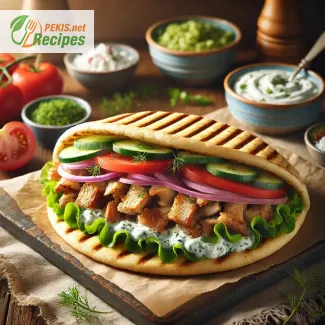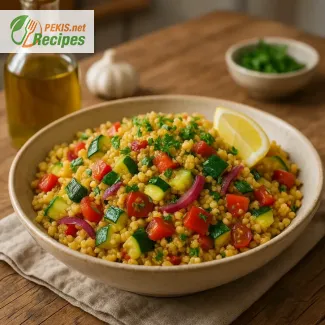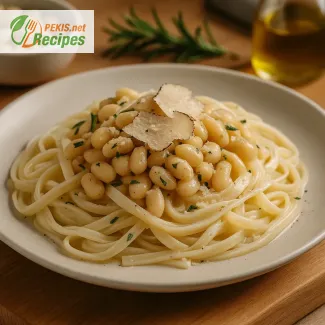
Authentic Greek Gyro – A Perfectly Seasoned Delight
The Irresistible Charm of a Homemade Gyro
Few dishes capture the essence of Mediterranean cuisine quite like the authentic Greek gyro. With its succulent, well-seasoned meat, crispy yet tender texture, and the perfect balance of herbs and spices, this dish brings the flavors of Greece straight to your table. Whether enjoyed in a warm pita wrap or served as a plated dish with fresh vegetables and creamy tzatziki, a homemade gyro is a true masterpiece of flavor and tradition.
The beauty of a traditional gyro lies in its simplicity and bold taste. Layers of marinated meat—typically lamb, beef, or chicken—are stacked, slow-roasted, and thinly sliced to achieve that signature texture. While street vendors in Greece cook gyros on a vertical rotisserie, a homemade version can be just as delicious when prepared with the right technique and seasoning blend.
The Secret to a Perfect Gyro
The key to a mouthwatering gyro recipe is in the seasoning and cooking method. A well-balanced combination of garlic, oregano, cumin, paprika, and coriander gives the meat its deep, aromatic flavor. The marinating process allows the spices to fully infuse into the meat, ensuring that every bite is juicy and full of rich, savory goodness. Cooking the meat properly—whether in the oven, on a grill, or in a pan—further enhances its texture and taste, making it both tender and slightly crispy on the edges.
Pairing the meat with homemade tzatziki sauce adds a refreshing contrast. The cool, creamy yogurt mixed with grated cucumber, garlic, and fresh dill creates the perfect balance to the spiced meat, enhancing the dish’s overall depth of flavor. A warm pita bread completes the experience, providing a soft, chewy texture that perfectly complements the rich filling.
Customizing Your Gyro for the Ultimate Experience
One of the great advantages of making gyros at home is the ability to customize them to personal preference. Whether using traditional lamb, a blend of beef and pork, or a lighter chicken variation, the results can be equally flavorful and satisfying. Adjusting the spice levels, experimenting with different herb combinations, or incorporating a variety of fresh toppings can elevate the gyro to new culinary heights.
For a healthier twist, opt for leaner cuts of meat, a whole wheat pita, or a low-fat tzatziki sauce. Adding a side of Greek salad or roasted vegetables can enhance the meal’s nutritional value while keeping the Mediterranean flavors at the forefront.
A Taste of Greece in Every Bite
There’s something truly special about preparing a gyro from scratch—from marinating the meat to assembling the final dish. The combination of bold spices, creamy sauce, and fresh ingredients creates an authentic dining experience that rivals any Greek restaurant. Whether serving it at a family gathering, a casual lunch, or a festive dinner, this gyro recipe is guaranteed to impress.
With the right techniques and quality ingredients, a homemade Greek gyro can transport you straight to the bustling streets of Athens or the sun-kissed shores of Santorini. Every bite is a celebration of Mediterranean flavors, bringing the joy of Greek cuisine to your table.
- Prepare the meat mixture: In a large bowl, combine the grated onion, minced garlic, oregano, cumin, coriander, paprika, cinnamon, salt, and black pepper. Mix well.
- Blend the meat: In a food processor, add the lamb or beef and the spice mixture. Pulse until the meat becomes a smooth, paste-like texture. Add the olive oil and red wine vinegar, then pulse a few more times until fully incorporated.
- Shape the meat: Form the mixture into a compact loaf shape and place it on a baking sheet lined with parchment paper.
- Cook the gyro meat: Preheat the oven to 180°C (350°F). Bake for about 40 minutes or until the internal temperature reaches 75°C (165°F). Let it rest for 10 minutes before slicing thinly.
- Prepare the tzatziki sauce: While the meat is cooking, grate the cucumber and squeeze out the excess liquid. In a bowl, mix the cucumber with Greek yogurt, minced garlic, lemon juice, olive oil, dill, salt, and black pepper. Stir well and refrigerate until ready to serve.
- Warm the pita bread: Heat a dry pan over medium heat and warm the pita bread for 30 seconds on each side.
- Assemble the gyro: Place a warm pita bread on a plate. Add slices of gyro meat, red onion, tomato, and lettuce. Drizzle with tzatziki sauce and top with crumbled feta if desired.
- Serve immediately and enjoy!
Elevating the Classic Gyro – Tips for a Superior Homemade Version
The Key to a Perfectly Balanced Gyro
A traditional Greek gyro is already a masterpiece of flavors, but with a few tweaks, you can take it to the next level. The secret lies in achieving the perfect balance of spices, texture, and freshness while avoiding common pitfalls. Whether you're looking to enhance the juiciness of the meat, adjust the spices for a bolder taste, or create a healthier version, small changes can make a significant difference in the final result.
Choosing the Best Ingredients for Maximum Flavor
The quality of ingredients plays a crucial role in the outcome of a homemade gyro. Using fresh, high-quality meat instead of pre-packaged options ensures a richer and more authentic taste.
- Meat selection: Traditional gyros are made with lamb, beef, or a combination of both, but using chicken or turkey can create a lighter yet flavorful alternative. Lamb has a more robust and earthy flavor, while beef brings a heartier, umami depth. Chicken gyros, when marinated well, offer a juicier and slightly milder profile.
- Seasoning adjustments: The classic Greek spice blend includes oregano, cumin, paprika, coriander, and garlic, but adding a hint of cinnamon or nutmeg can bring out a subtle warmth in the meat. For a smoky touch, a small amount of smoked paprika enhances the depth of flavor.
- Tzatziki sauce refinement: A great gyro isn’t complete without a creamy and refreshing tzatziki sauce. Using full-fat Greek yogurt creates a rich, velvety texture, while adding a splash of olive oil elevates the smoothness. Fresh dill and lemon juice brighten the flavors, and grating the cucumber finely ensures even distribution without overpowering the sauce.
The Benefits of Homemade Gyros Over Store-Bought
Preparing gyros at home allows full control over the quality of ingredients, seasoning intensity, and cooking methods. Many pre-packaged or restaurant versions rely on processed meat, excessive sodium, and artificial flavor enhancers, which can diminish the authenticity of the dish.
- Customizable spice levels: Making your own spice blend ensures a more personalized flavor profile. Adjusting the amount of garlic, salt, and herbs can cater to individual tastes while maintaining the Greek essence.
- Better cooking techniques: Unlike store-bought gyros, which may contain preservatives and fillers, homemade versions allow for a cleaner, fresher taste. Cooking the meat in small batches on high heat can create a perfect crust, while slow roasting ensures tender, juicy slices.
- Healthier choices: Preparing gyros at home gives the option to use leaner meats, whole wheat pita, and low-fat yogurt, making it a more nutritious meal without sacrificing flavor.
Common Mistakes to Avoid When Making Gyros
Even with the best ingredients, a few missteps can affect the final dish. Avoiding these errors can help achieve the perfect texture and taste.
- Skipping the marination process: Marinating the meat for at least 4 hours (preferably overnight) ensures that the flavors penetrate deeply, making each bite more aromatic and juicy.
- Overcooking the meat: Cooking gyro meat at too high a temperature for too long can result in dry, tough slices. Instead, roasting at a moderate temperature followed by a quick high-heat sear locks in moisture while creating a crispy exterior.
- Using too much or too little tzatziki: While tzatziki enhances the dish, an overwhelming amount can overpower the spices in the meat. A light drizzle allows the flavors to complement each other without masking the savory seasoning.
- Choosing the wrong pita bread: A soft, slightly chewy pita that is warmed before assembling helps keep the gyro intact and enjoyable. Dry or stale pita can lead to cracking and difficulty in wrapping.
Healthier Alternatives Without Compromising Taste
For those looking to enjoy gyros with a lighter twist, a few modifications can make the dish healthier while still preserving its bold flavors.
- Opting for lean meats: Instead of lamb or beef, using chicken breast, turkey, or even plant-based protein reduces saturated fat while still maintaining a savory, well-seasoned taste.
- Whole wheat or gluten-free pita: Swapping regular pita for whole wheat adds extra fiber and nutrients, while gluten-free wraps or lettuce cups cater to dietary restrictions without losing the gyro experience.
- Low-fat tzatziki: Using low-fat Greek yogurt instead of full-fat reduces calories while keeping the sauce creamy and flavorful. Adding a bit of avocado can also enhance the texture with healthy fats.
Experimenting with Unique Flavor Enhancements
For those who love to experiment with flavors, adding new ingredients can elevate the gyro experience.
- Spicy gyros: Incorporating chili flakes or harissa into the spice blend adds a kick of heat, perfect for spice lovers.
- Mediterranean-inspired toppings: Adding roasted bell peppers, olives, or pickled onions introduces a new layer of complexity and tanginess.
- Cheese variations: While feta is the classic choice, experimenting with grilled halloumi or kefalotyri can add a rich, salty contrast to the dish.
Assembling the Ultimate Gyro
To ensure that every bite is balanced and delicious, layering the ingredients correctly makes a difference.
- Start with a warm, soft pita to ensure easy folding.
- Spread a thin layer of tzatziki to create a flavorful base.
- Add a generous portion of thinly sliced, crispy-edged gyro meat.
- Layer with fresh vegetables like tomatoes, red onions, and lettuce for crunch and freshness.
- Drizzle with extra tzatziki sauce for a creamy contrast.
- Optionally, sprinkle with crumbled feta or a squeeze of lemon juice for added brightness.
- Wrap the pita securely to hold all ingredients together.
A well-prepared gyro is more than just a meal—it’s a culinary experience that captures the essence of Greek cuisine. By fine-tuning the spices, cooking methods, and ingredient choices, anyone can create an even more flavorful, juicy, and authentic homemade gyro that surpasses any takeout version.
- Contains gluten (pita bread).
- Contains dairy (Greek yogurt, feta cheese).
- Contains garlic (potential allergen for some individuals).
Ingredient substitution tips for allergens and gluten:
- Gluten-free option: Use gluten-free pita bread or lettuce wraps.
- Dairy-free option: Replace Greek yogurt with coconut or soy yogurt, and omit feta cheese.
- Garlic-free option: Reduce or replace garlic with a pinch of asafoetida.
- Vitamin A: Supports vision and immune function.
- Vitamin C: Strengthens the immune system and promotes skin health.
- Vitamin B6: Helps with metabolism and brain function.
- Iron: Supports red blood cell production and oxygen transport.
- Calcium: Essential for strong bones and teeth.
- Magnesium: Supports muscle function and relaxation.
- Lycopene (from tomatoes): Protects against oxidative stress and supports heart health.
- Flavonoids (from herbs and spices): Reduce inflammation and boost immune defense.
- Vitamin C (from lemon juice and vegetables): Neutralizes free radicals and enhances skin health.





